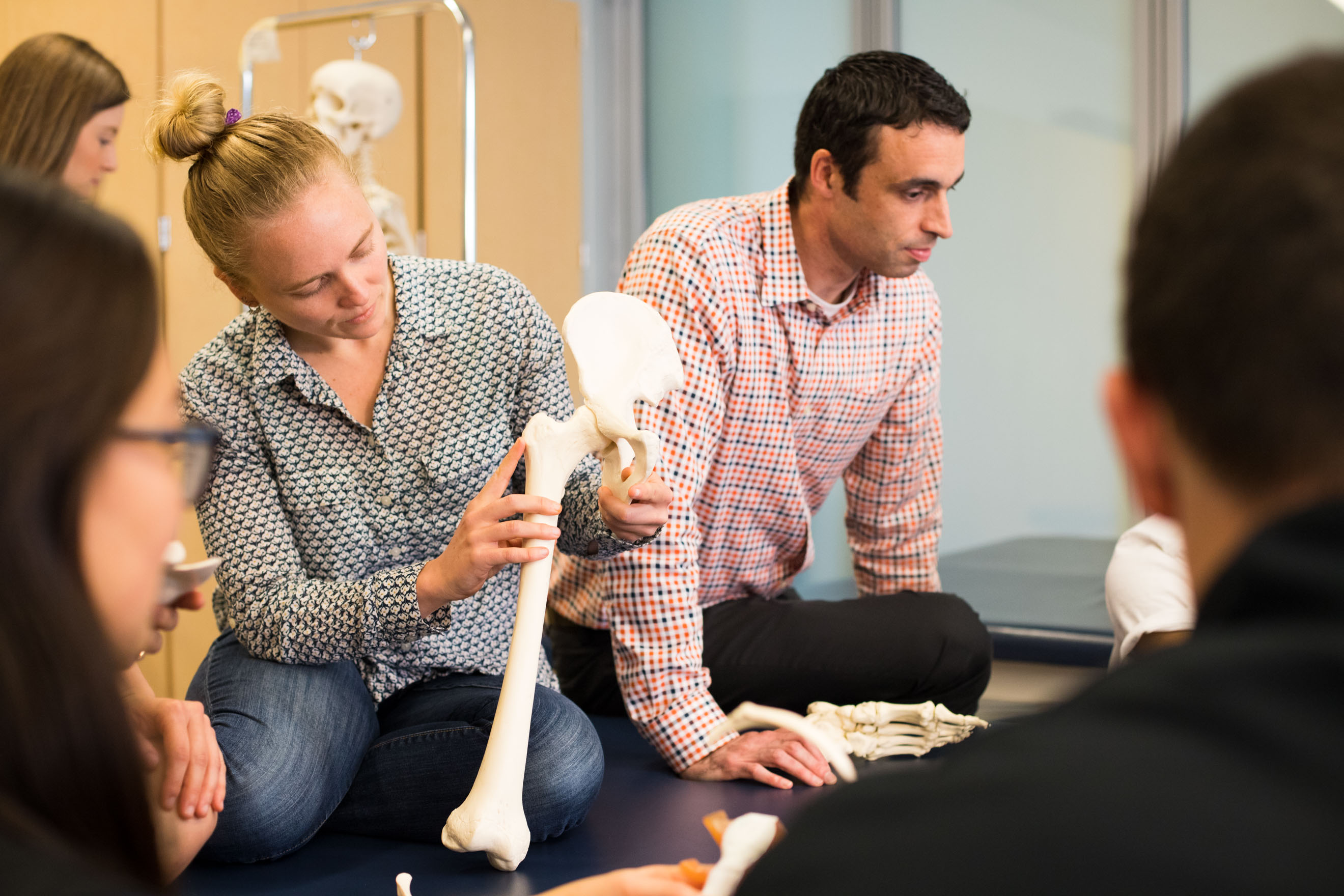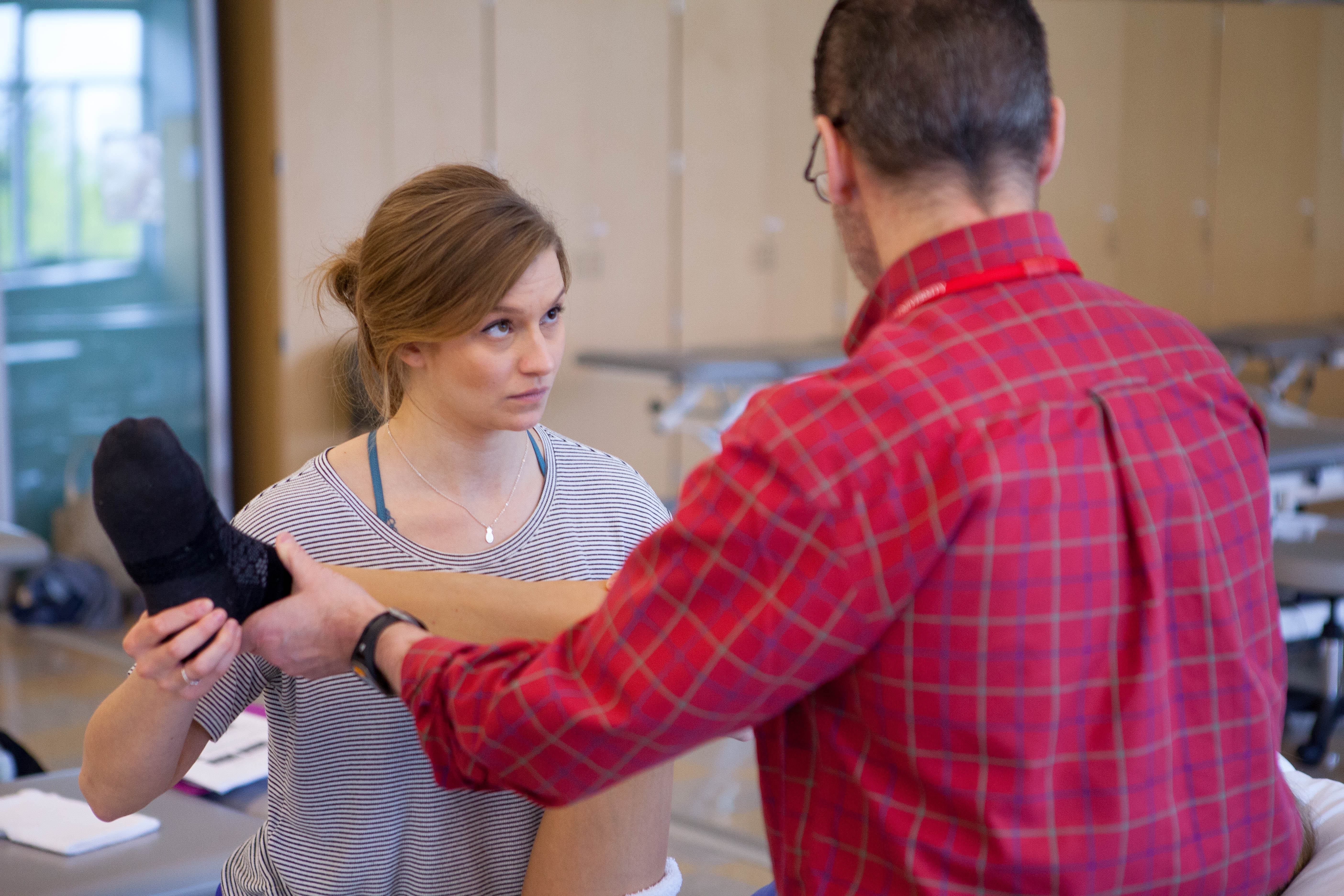Spend equal time in the clinic and the classroom with Pacific’s entry-level physical therapy program.
Inquire today and speak with an expert admissions counselor to begin your path toward physical therapy school. Admissions for the 2025-2026 school year will open this upcoming summer, and you can prepare in advance to submit your application as soon as possible.
Becoming a physical therapist has never been more accessible thanks to a wealth of new doctor of physical therapy (DPT) programs popping up across the country.
With the average salary of a physical therapist being nearly $95,000 and a recent U.S. News & World Report study ranking physical therapy in the top ten best professions for job satisfaction, pay, and work-life balance, it’s not hard to see why physical therapy school has become so popular for those wanting an emotionally-rewarding career in healthcare.
So, how do you become a physical therapist? There’s a lot to consider, but with our guide meeting the requirements for physical therapy school can be tackled with ease.
Including the time to earn an undergraduate degree, you can be ready to start helping people to live healthy and active lives in as little as seven years.
What bachelor’s degree do I need to attend physical therapy school?
The short answer is that any undergraduate degree can be accepted as long as you have taken the prerequisite classes required for your desired DPT program. This means that whether you’ve majored in dance, public health, or even accounting, you can still apply for physical therapy school.
However, due to heavy prerequisites in math and science, certain degree paths can better prepare you for the rigors of a physical therapy program.
These degrees include kinesiology, biology, athletic training, and exercise science. Many universities also offer a specialized pre-physical therapy degree track that prepares you for physical therapy school.
Missing a course or two? You can still apply and even be accepted to Pacific’s School of Physical Therapy and Athletic Training with prerequisites still in-progress as long as you complete the missing classes before your first semester.
I’m almost done with my undergrad. Now what?

There are over 200 physical therapy programs in the United States, so choosing which to apply to can seem like a daunting task. Luckily, the Physical Therapist Centralized Application Services (PTCAS) platform makes comparing programs by prerequisites, deadlines, and application materials a breeze.
Easily sort and save accredited schools and discover what you need to complete your application.
While many schools require the GRE (a lengthy and difficult standardized exam), Pacific does not, and will not use your scores as a determining factor in your application.
It’s also important to point out that you do not need to take the MCAT (another lengthy and expensive medical school test) to apply to physical therapy school. So what should you do to prepare instead of taking all those tests?
-
Join your school’s pre-physical therapy club. Not only is a pre-physical therapy club good for meeting other students applying to programs across the country, but they also attract visits from admissions professionals and healthcare organizations.
-
Volunteer at local clinics. No matter how strong your application, the more observational experience you have the better. Time spent in a healthcare setting can mean the difference between admission and the waitlist.
-
Reach out to doctoral programs. Most schools of physical therapy have dedicated admissions counselors who can answer your application questions as well as invite you to on-campus tours.
I’ve been out of school for a few years. Can I still apply?
Yes! Regardless of your current career, education, or geography, you can still become a physical therapist. Physical therapy cohorts contain a diverse array of students and backgrounds, meaning that there is space for everyone.
Many applicants that are interested in a career change choose to complete missing prerequisites at the local or community college level before applying, meaning that they are on the same level as those who have recently graduated with an undergraduate degree.
In short: don’t worry. It’s not too late to apply to physical therapy school.
The faculty genuinely care about student success. They recognize that each cohort is different and include us in conversations about how they can strengthen the program for our benefit.
– Carolyn Nevin '25
How do I find the application for physical therapy school?

PTCAS is like the Common App in that you submit your materials and then can apply to multiple schools at once. Programs have slight differences in what you need to submit, but generally they will ask for a variation of the following:
-
Official college transcripts including your cumulative GPA and the GPA of all of the program's prerequisite courses.
-
A minimum of 100 hours of documented healthcare observation experience.
-
Professional references, at least one of which must come from a licensed physical therapist.
-
A brief personal essay specific to your desire to become a physical therapist.
The PTCAS has a lot of moving parts, so it’s recommended that you have all of the necessary application materials ready before you begin the application process.
If you have questions, either about PTCAS or specific application materials, reach out to your desired program’s admissions counselor.
After you submit your PTCAS (Pacific's preferred deadline for November interviews is September 15) you may be asked by some of the schools to participate in a series of virtual or in-person interviews.
These interviews not only allow you to strengthen your application, but also to ask questions and, if in-person, see the campus at which you’ll be studying as well as talk to current students.
After that, all you can do is wait.
I immediately knew this program would challenge me, allow me to grow as an individual, and become a well-rounded physical therapist.
– Janelle Matsuoka '24
I got in! Now what?
First of all, congratulations! Physical therapy school is difficult to get into, but you’ve proven to the admissions committee that you are ready for what the program has to offer.
You may even have the (excellent) problem of having to choose between more than one school. If you find yourself in that situation, here’s what to keep an eye out for.
-
Clinical placements. In addition to your academic classes, spending time in a genuine clinical setting is essential to not only become a physical therapist, but also in landing a job after graduation. Choose programs that go beyond the bare minimum needed for licensure.
Pacific’s DPT program guarantees at least 39 weeks of full clinical placement. That’s 40% of the program spent getting hands-on job training and networking with working professionals in your area.
Do you dream of working with veterans? We can connect you. Research hospitals calling your name? We know someone. Want experience overseas? Just say the word.
Working with and being mentored by professionals in your desired field of study is the best way of securing a job after graduation, and Pacific’s commitment to clinical placement makes that happen. -
Program organizations. There should be opportunities for cohort engagement outside of the classroom. Whether this takes the form of a student-led community or volunteer efforts within the campus community, extracurricular activities can help create an intimate and compassionate physical therapy program experience.
Pacific is proud to house the Collective for Diversity and Social Justice, a group of program students, staff, and community members who help to create a space for cultural representation in and out of the physical therapy program. -
Professional license rate. The program you choose should be able to back up its reputation. Pacific boasts a 100% pass rate of the National PT Exam for licensure and over 90% of Pacific DPT graduates find meaningful employment in their field after only six months.
Pacific students who have completed their required clinical training can even choose to take their licensing exam while still in school, getting into their careers faster after graduation.
Graduate and Thrive.
After graduation, take your licensing exam – passing the licensing exam is only possible if you have, or are going to complete, a DPT – and connect with your program’s alumni network.
Often, the clinics and healthcare settings you were placed in during your program will have openings and the exposure to those workplaces that you received while earning your degree will become invaluable. Good luck!
Learn more about Pacific’s industry-leading physical therapy program and reach out to an admissions counselor to take the first step to become a physical therapist!